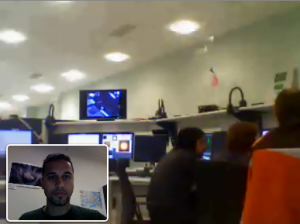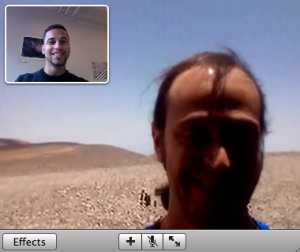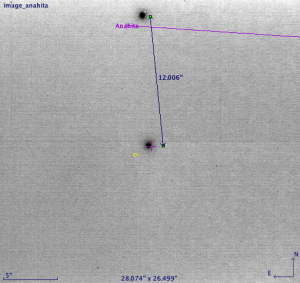One night of observations at Paranal, Chile
First day of 2009 in my office at UC-Berkeley
January 6, 2009Post-observing report of the VLT Paranal and Pictures
January 8, 2009Hello readers,
Today I am going to describe using an example how astronomers work and collaborate.
I am part of an observing project aimed at calibrating with an excellent accuracy the distortion of the near-infrared detector called CONICA mounted on the Adaptive Optics system of the Yepun telescope of the VLT (called NAOS). Thierry Forveille from the Observatoire de Grenoble in Astrophysics is the PI of this technical project. My contribution is to provide appulse event calculations. An appulse (or conjunction) is a close passage of an asteroids nearby a bright star. They are useful to measure the effect of distortions following the velocity variations of the asteroid. I don’t want to enter in the details of the technique, but to summarize, to perform this project we had to calculate the position of thousands of asteroids for the night of the VLT observations and check if any of them was passing nearby a bright stars (10th-12th magnitude in visible). My colleague Jerome Berthier from the IMCCE at the Observatoire de Paris made the raw calculations during the holidays using the powerful ephemeris computers available in his institute. I selected the appropriate events from a list of one hundred calculated appulse taking into account the characteristics of the telescope (its location) and the instrument (brightness of the asteroid and the star). After calculating the positions of ~1500 asteroids (4 days of calculations) we got only ~10 events observable over 110 predicted.
In the past, I had already observed appulse events using the Lick and Keck telescopes equipped also with adaptive optics. We were using these events to get a sharp image of the asteroids to see if they have a companion. However, I could not go to the Chile to conduct the observations, so another co-I (co-Investigator) on the project went there for us. Herve Bouy used to work at UC-Berkeley, we know each other for more than 3 years now. He recently moved to the IAC in the Canary Islands but “volunteered” to go to Chile to observe.
As soon he arrived, we started communicating by email but also by video chat. I show on the left both of us chatting from his hotel room at Paranal Observatory while I am in my office at UC-Berkeley. You may know the Paranal observatory since the last James Bond movie (Quantum of Solace) was partially recorded in the hotel. The observatory is located to the North of Chile near Antofagasta in one of the driest area in the world (Atacama desert), a perfect site for astronomers. It is definitely one of the best sites for astronomy and the European Southern Observatory built there four 8.2m telescopes called the Very Large Telescope (VLT). We will use one of them. It is not easy to obtain observing time on these telescopes. This is for instance the only night to which I am involved for this semester. We seem to have fun on this snapshot but in fact we were both discussing the method of observations and the details for the night. It is very important not to waste time for such precious telescope making sure that we all agreed on the procedure of observations before the run starts. We exchanged between the three of us ~40 emails over the last 2 days to discuss various details and problems.
 At the time I am writing this blog, Herve is in the control room and started observing. The seeing is not very good (2″) and quite variable but he successfully recorded the first appulse between the asteroid (270) Anahita, a 50 km diameter asteroid located in the main-belt, and a Tycho-2 star. Anahita will be passing at ~12 arcsec from the star at 01:11 UT following our calculation. This is an apparent appulse, meaning that the projected distance between the two bodies is small but they are in fact far away from each other. The asteroid is in the foreground very close to us at 1.4 AU (12 min light year), whereas the star in the Milky galaxy but far away at more than 3 light-years most likely.
At the time I am writing this blog, Herve is in the control room and started observing. The seeing is not very good (2″) and quite variable but he successfully recorded the first appulse between the asteroid (270) Anahita, a 50 km diameter asteroid located in the main-belt, and a Tycho-2 star. Anahita will be passing at ~12 arcsec from the star at 01:11 UT following our calculation. This is an apparent appulse, meaning that the projected distance between the two bodies is small but they are in fact far away from each other. The asteroid is in the foreground very close to us at 1.4 AU (12 min light year), whereas the star in the Milky galaxy but far away at more than 3 light-years most likely.
Herve just sent me an image recorded recently and we can see the asteroid and star very close to the expected position. The separation for this appulse is quite large (12″). We have more appulses to observe tonight for which the separation will be ~3″.
To conclude, the experiment works 🙂 That’s a good news. Let’s hope the seeing will improve and Herve will be able to get more data. After the observations we will most likely decide who will conduct the data processing and the analysis. We have a second night of observations for the same program in June 2009, so it is mandatory to have some results before that night.
I am off for today…
Clear skies,
Franck M.




